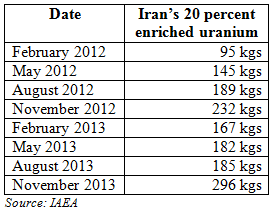You Might Have Missed: Nuclear Iran, Drone Markets, and Terrorism

More on:
“Implementation of the NPT Safeguards Agreement and Relevant Provisions of Security Council Resolutions in the Islamic Republic of Iran,” International Atomic Energy Agency, November 14, 2013.
Since Iran began enriching uranium at its declared facilities, it has produced at those facilities:
- 10 356 kg (+653 kg since the Director General’s previous report) of UF6 enriched up to 5% U-235, of which 7154.3 kg (+380.3 kg since the Director General’s previous report) remain in the form of UF6 enriched up to 5% U-235 and the rest has been further processed (as detailed in paragraphs 22,28 and 41 below)

Hon. Matthew G. Olsen, “The Homeland Threat Landscape and U.S. Response,” Senate Committee on Homeland Security and Governmental Affairs, November 14, 2013.
Despite core al-Qaida’s diminished leadership cadre, remaining members will continue to pose a threat to Western interests in South Asia and will attempt to strike the Homeland should an opportunity arise…Al-Qaida in the Arabian Peninsula (AQAP) remains the affiliate most likely to attempt transnational attacks against the United States…
Homegrown Violent Extremists (HVEs) remain the most likely global jihadist threat to the Homeland. While the threat posed by HVEs probably will broaden through at least 2015, the overall level of HVE activity is likely to remain the same: a handful of uncoordinated and unsophisticated plots emanating from a pool of up to a few hundred individuals. Lone actors or insular groups who act autonomously pose the most serious HVE threat.
United States of America v. Tarek Mehanna, United States Court of Appeals for the First Circuit, November 13, 2013.
Terrorism is the modern-day equivalent of the bubonic plague: it is an existential threat.
“Air Force to ‘Add More Rigor’ to Screening of Candidates for Nuclear Commander Jobs,” Washington Post, November 13, 2013.
The review will include a Google search, a simple task that hadn’t been done before. “What pops up when you type somebody’s name into Google?” Welsh said. “It might be worth knowing that before you nominate somebody for a key job. Some of this is common sense.”
Brian Bennett and Michael A. Memoli, “No Partisan Divide on Obama’s Homeland Security Nominee,” Los Angeles Times, November 13, 2013.
As American warplanes dropped bombs on Libya in June 2011, lawmakers accused the Obama administration of usurping Congress and violating the War Powers Resolution. From his office in the Pentagon’s E-Ring, Jeh Johnson, then general counsel at the Defense Department, penned advice to the president: Go to Congress for approval…
But Johnson’s dissent may pay off now: It won him some fans among Republicans in Congress, and they haven’t forgotten.
“Department of Defense Press Briefing with George Little from the Pentagon,” U.S. Department of Defense, November 12, 2013.
George Little: One of the reasons that we in the Department of Defense, the U.S. military, have a very high approval rating with the American people is because we are transparent. Even when it’s bad news, quite frankly, we tend to come forward quickly and own up to it and talk about the measures we’re taking to ensure that the problem doesn’t occur again.
Steven Aftergood, “Pentagon Drone Programs Taper Off (and New Military Doctrine),” Secrecy News, November 12, 2013.
The Department of Defense budget for research and procurement of unmanned aerial systems (UAS), or drones, is on a distinctly downward slope.
The FY 2014 budget request included $2.3 billion for research, development, and procurement of unmanned aerial systems, a decrease of $1.1 billion from the request for the fiscal year 2013.
“Annual procurement of UAS has gone from 1,211 in fiscal 2012 to 288 last year to just 54 in the proposed FY14 budget,” according to a recently published congressional hearing volume.
Guy Taylor, “U.S. Intelligence Warily Watches for Threats to U.S. National Security Now That 87 Nations Possess Drones,” Washington Times, November 10, 2013.
This matters because of the roughly 20,000 drones now in existence, only about 350 are large enough to carry the slate of weapons on the current market.
More on:
 Online Store
Online Store